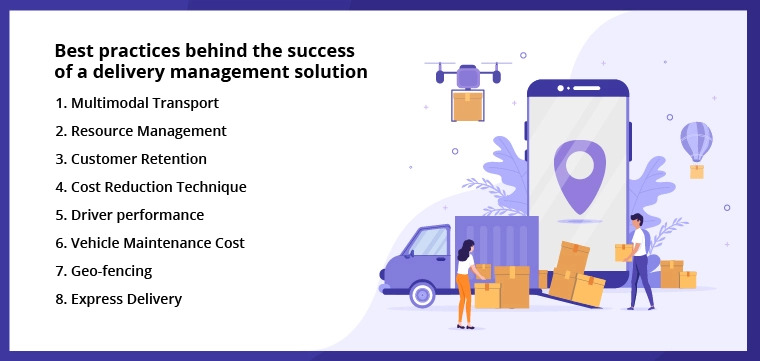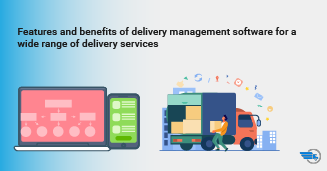Best practices behind the success of a delivery management solution

Entrepreneurs need a delivery management solution for reducing the cost of operations and improving productivity. They have different types of fleets to ensure faster delivery. Logistics providers want to use the resources effectively. They need software to track their vehicles. The main aim of the software is to retain happy customers. Vehicle maintenance cost plays a vital role to get the profit from the logistics business.
Designed for Multimodal Transport Support
Logistics providers use different transport models for managing delivery operations. They do not depend on a single transport channel. Multimodal transport uses multiple vehicles like trucking, airplane, train, and ship, and they are combined together to facilitate the fast movement of goods. This transport model needs little effort and a shorter time. Maritime shipment is cheaper than air travel. It needs more time for completing the dispatch. Train transport is significantly cheaper than trucking and used for long-distance delivery.
The delivery management solution integrates with multiple carriers and shipping partners, allowing businesses to access a vast network of transport options. By dynamically selecting the most suitable transport mode based on factors like cost, distance, urgency, and cargo type, it optimizes the delivery process and reduces delays.
The solution offers real-time tracking and visibility across the entire supply chain. Customers, as well as businesses, can monitor the progress of their shipments at every stage. If a delay or disruption occurs during one mode of transport, the system can proactively identify alternative routes or transportation methods to ensure on-time delivery.
Efficient route planning is another crucial aspect facilitated by a delivery management solution. It considers multiple transportation modes in the journey, creating optimized paths to minimize transit times and fuel consumption. This approach not only streamlines the delivery process but also reduces the carbon footprint, promoting sustainability in the logistics industry.
Peripheral Benefits of Using Delivery Management Solution
Customer Loyalty Retention: On-time delivery is crucial for improving customer satisfaction. An embedded route planner with GPS tracking helps the business operator to plan optimized routes for dispatch. It considers traffic conditions, bad weather, and other constraints for route optimization. GPS tracking estimates the accurate time of arrival to customers. A field service business that implemented a route optimization system increased punctuality among its staff.
Cost Reduction Technique: One of the best ways to reduce operational costs is to minimize the cost per delivery. It should be calculated accurately and minimized. This software is developed with an automated process and route optimization feature. The automation process helps to reduce manpower and saves more money. The route optimization technique reduces operational costs. The most significant advantage of route planning is to save fuel. Identifying and reducing unnecessary consumption of fuel is important in the cost-reduction process. The management team keeps lower costs to make the consumers happy.
Driver performance: The driver can plan the route manually. It won't, however, give the real-time vehicle location and the business operator may not know the reasons behind the delivery delays. So, the logistics provider will never know the delay because of any bad environmental conditions, or extended breaks. A route planner system with advanced features like GPS tracking will allow you to monitor the drivers in real time. This will prevent drivers from taking long breaks, and stop them from using vehicles for personal use during working hours.
Vehicle Maintenance Cost: Bad driving habits increase fuel consumption and maintenance costs. Vehicle breakdowns and unexpected repairs make a delay in delivery. The fleet operator will get actionable data on drivers' on-road habits, which can be used to train them in good driving habits and reduce wear and tear costs.
Geo-fencing: Delivery Management Software offers Geo-fencing. This is a powerful technology that goes unnoticed frequently. Geo-fencing creates virtual boundaries around specific places on the map. It triggers an alert when the vehicle enters or exits the designated area. This feature prevents vehicle theft and reduces the chances of drivers using business vehicles for personal use.
Express Delivery: Every customer wants the products delivered at a suitable time. The majority of people are adopting a fast-moving lifestyle, and they need immediate dispatch. This delivery management system is developed to provide the dispatch expediently. Therefore, this system is developed differently In today's competitive business landscape, entrepreneurs and logistics providers need a reliable delivery management solution to enhance operational efficiency and ensure customer satisfaction. These solutions support various types of fleets and transportation models, enabling businesses to optimize resources and reduce costs effectively.
Optimized Resource & Assets Management Capabilities
Logistics providers use fleet vehicles and inventory efficiently to improve business revenue. Delivery schedules can be done to use vehicles efficiently. If the organization needs an additional warehouse during the seasonal time, then they can take it on rent for brief time. The installation of a huge warehouse needs heavy investment, and it is not useful for non-seasonal times. If the logistics operator provides an effort-based payout, then the delivery management software will help to calculate the payout accurately.
Delivery management solutions play a pivotal role in ensuring efficient resource management for transportation and delivery operations. By leveraging advanced technologies and intelligent algorithms, these systems streamline the entire logistics process, resulting in cost savings, improved productivity, and enhanced customer satisfaction.
Here is how efficiency is achieved.
Optimization: Delivery management solutions utilize algorithms that optimize delivery routes and schedules based on various factors like distance, traffic conditions, delivery time windows, and vehicle capacities. By minimizing idle time and reducing fuel consumption, these solutions enhance resource efficiency.
Real-time tracking: Automated delivery solutions enable real-time tracking of delivery vehicles, ensuring better visibility into their location, status, and estimated time of arrival. This visibility allows for effective resource allocation, enabling dispatchers to reassign tasks dynamically and manage resources efficiently.
Resource utilization: Delivery management solutions analyze historical data to identify patterns and trends, helping businesses forecast demand and allocate resources accordingly. This ensures that the right number of vehicles and delivery personnel are available to meet fluctuating delivery demands, avoiding both overstaffing and understaffing scenarios.
Automation and integration: The solutions often integrate with other business systems like order management, inventory management, and warehouse management systems. This integration streamlines the entire delivery process, automating tasks such as order processing, inventory updates, and route planning. Automation reduces manual errors and optimizes resource allocation.
Smart scheduling: With real-time data and analytics, delivery management solutions facilitate smart scheduling. They consider factors like delivery urgency, customer preferences, and location proximity, enabling businesses to prioritize deliveries efficiently. This prevents delays and ensures timely deliveries, leading to improved customer satisfaction.
Predictive maintenance: The systems can incorporate predictive maintenance features, which monitor the health of delivery vehicles and predict potential maintenance needs. By detecting issues before they escalate, businesses can proactively address vehicle maintenance, reducing downtime and optimizing resource usage.
Customer communication: Efficient resource management involves keeping customers informed about their delivery status. Delivery management solution often provide automated notifications and real-time updates to customers regarding the status of their orders, thus reducing customer inquiries and enhancing the overall delivery experience.
A well-implemented delivery management solution empowers businesses to manage resources efficiently, optimize transportation operations, and deliver products promptly to meet the expectations of modern customers in a fast-paced world. It is a must-have tool for logistic business owners who want to outstrip the competition and grow by leaps and bounds.
Latest Posts
- Transforming E-commerce: How Seamless Order Management Enhances Customer Experience
- Fast Track Optimization: The Art and Science of the Most Efficient Route Planner
- Mastering Efficiency: The Role of Real-time Tracking Solutions in Restaurant Business
- The Future of Delivery: How Streamlined Logistics Can Transform Your Operations
- Real-time Handling: Key to Solving Dispatch Delivery Problems
- The Powerful Impact of Grocery Delivery Management System on Retail Business
- Benefits of an Automated Dispatch Software for your Business
- Six Essential Task-handling Features in Delivery Tracking System Software
- 8 Reasons to Implement Software-based Dispatch Management in this Era
- Reengineering Urban Mobility: Unveiling the Power of Dispatch Delivery Management System
